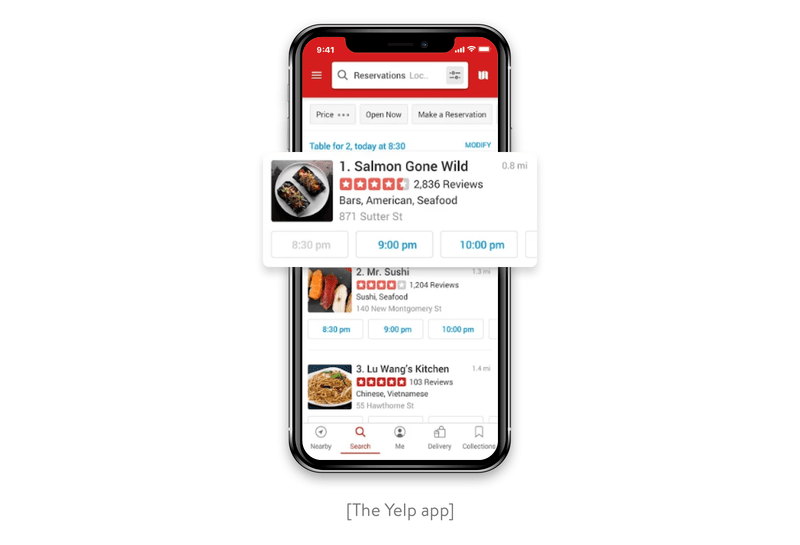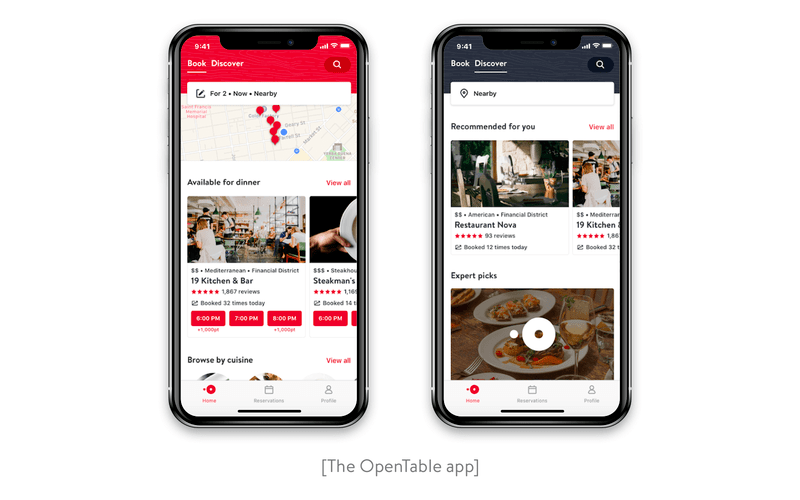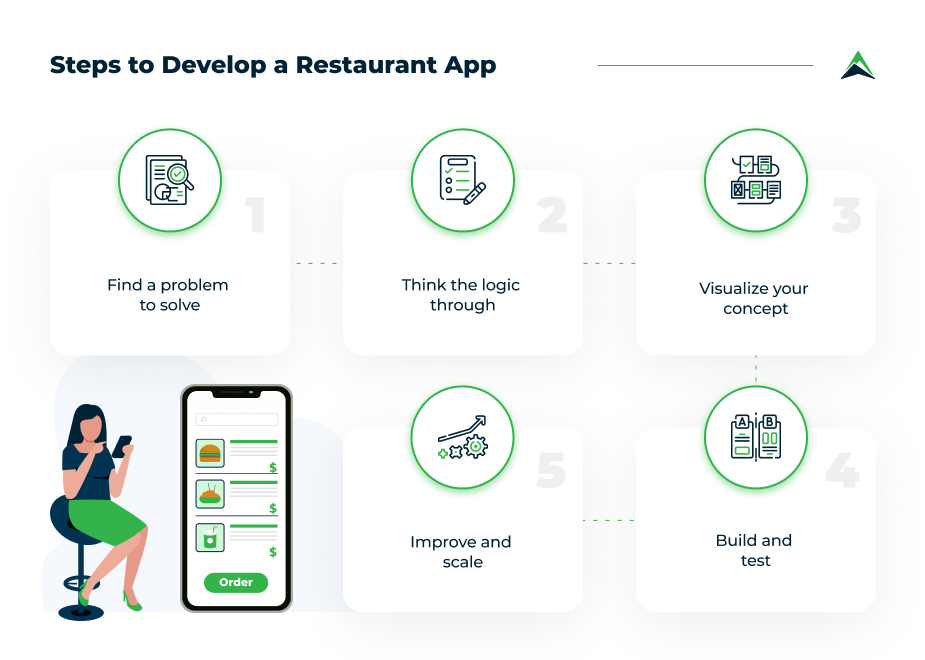The article was updated on October 13, 2023.
Every industry is undergoing digitization these days, and the restaurant industry is no exception. While it seems like nothing is more mundane than going out to eat or ordering takeout, restaurant apps literally have a lot to bring to the table. Enhanced customer engagement and better experiences help restaurant owners expand their client base and boost revenues.
Currently, the restaurant app market is booming. As per QSR research, by 2023, the digital food ordering and delivery segment alone is set to reach $365 billion.
Apart from restaurant apps for food delivery, and web-based ordering platforms, the range of restaurant apps you can invest in is truly impressive. This represents an opportunity for restaurant owners to capitalize on the growing demand for a better, digitized dining experience.
In this article, we will focus on how to create a restaurant app: the possible business models, key features, and a suggested roadmap for app development. So, read on to learn more.
Benefits of restaurant app development
People love restaurant apps for obvious reasons. As far as customers are concerned, ordering food via an app, choosing a place to eat, checking out menus, and reading testimonials all via an attractive app interface adds zest to the everyday dining experience.
But why should restaurant owners consider building proprietary mobile apps?
Below are some solid reasons why restaurant app development is totally worth the effort from a business perspective.

Increase in sales
This may seem too obvious, but digital orders will increase your sales. At a physical venue, you are limited by the available space. To make things worse, an overly crowded restaurant negatively impacts diners’ experience and many users actually prefer using a mobile app for restaurant ordering rather than visiting a physical location.
Online booking options will also increase the number of visitors who will appreciate the convenience of making reservations with an app.
Brand loyalty and customer engagement
Restaurant mobile apps will help you stay in touch with your customers, create brand awareness, and even build relationships. Through an app, they can get notifications about your hottest specials, news, and discounts, and restaurant owners may collect feedback, hold contests, or run polls and surveys.
Easy payment processing
Another important factor helping increase customer loyalty is enabling them to pay via an app. A lot of people find it more convenient than carrying around cash or plastic cards, besides, it frees up the time of your personnel and enables them to focus on the more important tasks. In general, the more payment types you accept, the better.
An effective way to get customer feedback
Apps are also great means of collecting customer feedback without having to run costly interviews and surveys. Based on customer testimonials, restaurants can instantly adjust to clients’ needs and requirements, tailor their offerings and provide a truly customer-oriented service.
The main types of restaurant applications (with examples)
You don’t need to own a restaurant yourself to build an app that targets this market. There are dozens of different app types (and their combinations) that cater to restaurant goers: from Yelp-like directories to on-demand delivery apps.
If you are planning to invest in restaurant app development, here are just a few of the most popular options to consider.
1. A restaurant review app
A restaurant review app is a restaurant directory where you can look through the venues nearby, find more detailed information about each one of them, and read actual reviews from the people who visited them.
Probably the most obvious example of this kind of app is Yelp.

2. A local restaurant finder
A local restaurant finder is another variation of a restaurant review app. These are location-based directories that let you find restaurants nearby (and often help you find your way to them).
A good example of such an app is Restaurant Finder.
3. A restaurant menu app
A restaurant menu app offers a digital interactive menu that users can access from their smartphones, as exemplified by Finedine. This restaurant application is a customizable SaaS solution for restaurant owners who want to digitize their ordering process and improve their customer experience.
Such restaurant apps are mostly offered using tablets with a pre-installed digital menu for its visitors to use. Yet, some restaurants prefer smart tables – interactive surfaces styled as dining tables where users can access pre-installed apps and multimedia.

4. A restaurant delivery app
A restaurant delivery app can allow you to place an order at a restaurant using a mobile app and have it delivered straight to your house.
There are two sub-categories of a mobile app for ordering takeout from a restaurant:
- aggregators and on-demand delivery apps like GrubHub (further examples include UberEATS, Postmates, etc.) or
- custom restaurant ordering apps for chains like Domino’s
5. A restaurant booking app
A restaurant booking app allows you to reserve a table at a restaurant right within the app. This functionality can be implemented as one of the features in a custom restaurant app or as standalone app for restaurant reservations, like OpenTable.

6. Restaurant promotional apps & loyalty programs
Promotional apps and loyalty programs provide access to special deals, coupons, and allow users to earn rewards when spending money at a restaurant. Yet, such apps often combine a loyalty program with a mobile checkout, allowing users to place their orders via an app, and bypass the waiting time typically associated with standing in a line.
Probably the most successful restaurant loyalty program application is the one created by Starbucks. Other notable examples include McDonald’s and Dunkin’ Donuts.
Some apps combine two or more app types listed above. For example, a restaurant reservation app can also help you find the locations of various restaurants nearby, and to check out their reviews as well as their menu.
And vice versa: restaurant finder apps, e.g. Zomato, often provide on-demand food delivery options and include the ability to book a table online.
The must-have restaurant app features
Although they might vary depending on your niche and business model, the core features of restaurant apps include:
- a digital menu, including photos and detailed info
- filters (by price, discounts, popularity of dishes, a filter with some main ingredient included, etc.)
- table reservation
- order placement (for takeout orders/delivery)
- payments (both the order payments and tips)
- online tracking to keep customers informed of the order status
- a loyalty program and promotions (special offers and deals, coupons, etc.)
- customer support: in-app chat for complaints and suggestions
- push notifications (location- or context-aware offers, and timely updates on the order status)
In addition to that, there are several restaurant app features that could contribute to the overall user experience:
- waiter call
- quick order (repeat your previous order in one click)
- user reviews and ratings for every position in the menu
- GPS tracking for order delivery
- locating restaurants nearby for restaurants that have multiple locations
- menu customization where visitors can add or exclude ingredients or choose the main ingredients themselves
- gamification features – a system of achievements, challenges, and tournaments where users can earn in-app currency that can be used to pay for the orders
- social media sharing
- chatbots
- third-party integrations (e.g. the ability to request an Uber without leaving the app as soon as an order is paid for).
Yet, these are the features for the customer-facing app.
In addition to that, your product must integrate with the restaurant management system or have a separate module for your staff to see and process the orders or requests sent via the app. This could include a standalone mobile app for the staff and an online portal for the manager/owner to keep track of the operations and processes and resolve any queries your staff isn’t entitled to.
In both cases, some training would be required for your staff to understand how the software works and to have no troubles operating it.
Explore our expertise in restaurants app development
Looking to develop software solution for your restaurant that would boost its operations and sales? Discover how we at Eastern Peak can help you reach your goals with our professional software development services.
How to develop a restaurant app: A suggested roadmap and key aspects to consider
Mobile app development is a major step for any business owner. Just like any other software development project, building apps for restaurants require solid tech expertise and professionalism.
And, while there is no surefire way to build a successful product, you should still take into account some crucial steps if you don’t want your time and money go to waste.
To get started (and to save your time and resources in the long run), consider the following roadmap for restaurant app development.
1. Find a problem to solve
As mentioned above, there are numerous opportunities for you to seize with restaurant app development. That is why it is important to choose the right niche and business model for your product. Depending on your business objectives, market specifics, and audience preferences, you should identify the app type that can bring the most value.
To make sure your app meets the demand, identify a specific sore point within your audience and target it. Try to solve a problem, to be useful, and offer some unique value. Otherwise, you won’t have a chance at competing with the established market players.
2. Think the logic through
At this stage, all the planning should take place. You have to finalize and document your app requirements. Having comprehensive and detailed specifications at hand, you can clearly communicate your needs and expectations to the team who will be handling the design and development.
3. Visualize your concept
As soon as you have finalized and documented your requirements, you can move on and visualize your app’s UI and UX. This means you can create the app design and finalize its user flow.
You can also make an interactive prototype of your app to review and test its usability using tools like InVision app. This will give you a better understanding of how the final result will look and feel (as well as help you pitch your idea to the investors before building an MVP).
4. Build and test
Finally, you can implement all of the features, according to the specs and design. At this stage, the key is to find a professional development team you can trust and let them do their job.
One more important aspect of developing a successful restaurant app is the quality assurance. Make sure each separate feature, and every single element of your app is thoroughly tested before you go live. Otherwise, you put all your invested efforts and resources at risk.
5. Improve and scale
Once the app goes live, you can (and should) utilize your user feedback to enhance the product value and further improve its customer experience. It’s also time to implement all the additional features that didn’t make it to the first version of your product.
If it is possible, taking into account your app type and business model, you can broaden your app’s target market by expanding into new locations as well.
Read more: Top 5 essential post-launch activities for your app

Food app ideas for your restaurant
The food delivery app segment is on the rise right now, but that doesn’t mean your scope of restaurant app development ideas should be limited to what’s currently trending.
10 of the options you may want to consider include the following:
1. Table booking app
Going out to eat will never get completely out of fashion. One way or the other, people will need to book restaurant venues for business meetings, friendly chats, family reunions, romantic dates, birthdays, or other events. A table booking app could help them do it in a convenient and classy manner.
2. AR-based app
Augmented reality can enhance a dining experience and make it truly captivating. The ideas for using AR in a restaurant app include
- creating an AR preview of the restaurant interior to help users envision what a friendly reunion or a romantic dinner would feel like;
- an AR-enhanced menu, enriched with pictures and multimedia, highlighting the interesting facts and the specifics of the cooking process;
- an ingredients’ check: by simply holding a smartphone next to a dish visitors can view its ingredients and nutrition facts;
- entertainment while waiting for food: recreational or educational content will minimize the perceived waiting time and keep visitors busy during courses.
The AR app development is still relatively new, so an AR app you develop stands a good chance of snatching a large market share and becoming everyone’s favorite.
3. Call a waiter app
You may also create a simple app enabling users to quickly call a waiter, instead of waiting to be served. This smart and practical restaurant app idea will help your customers save precious time and create a smooth pleasant dining experience. By simply scanning a QR code, users are sending a notification to a waiter’s device and minimizing wait times.
4. Create your dish app
This app grants your clients an opportunity to customize their orders. Let’s face it, when orders are given by word of mouth, mistakes and misunderstandings occur. A digital app, enabling users to specify the ingredients they want to add to their order, will reduce errors and help users personalize their orders in a fun and engaging way.
5. Recipe app
A great way of keeping your customers engaged is by sharing some of your secrets. With a recipe app, for example, you may offer users an opportunity to recreate their favorite dishes from your restaurant in the comfort of their homes. You may also add some tips and tricks for those who want to learn to cook like real chefs.

6. Kids’ menu
If you run a family restaurant, launching an app with menu suggestions for kids of all age groups may help you nab more orders. A great solution for busy parents, this app could help them save time by offering healthy and great-tasting food for their little ones.
7. Coupons and discounts app
If customer loyalty and retention is your primary concern, an app distributing discounts and special offers is the way to go. By simply naming the numbers appearing on their smartphone screens, users may get to enjoy gifts and other bonuses that will make them feel especially welcome.
8. Feedback and rating app
For established restaurants willing to improve their customer experience, feedback and rating apps may become a great means of keeping the lines of communication open between them and their customers.
9. Restaurant management app
This is, essentially, a proprietary platform for managing your restaurant’s back-office processes. Digitizing your kitchen/restaurant management can help you in a number of ways:
- automating time-consuming routines;
- providing data analytics and insights;
- scheduling timely repairs of kitchen equipment; and
- managing and keeping track of supplies.
The customers may never know this app exists, but they will surely feel its positive impact and appreciate an enhanced quality of your services.
10. Order and delivery marketplace
Alternatively, you may opt to compete with food delivery giants like DoorDash, Zomato, and UberEats, and create a digital marketplace for food order and delivery. This business model implies your platform will connect restaurants, companies, and delivery companies, and enable you to drive revenue from transactions.
Our experience in building solutions for restaurants
At Eastern Peak we have developed a solution for restaurants and bakeries called All-Eat-One that covers every front of house digital interaction between them and their customers.
A platform allows restaurants to improve their production by anticipating orders, manage reservations and waiting lists in case of cancellations, speed up the service in high traffic occasions, attract new customers and build a customer database, increase their sales and average check, and many more.
The main features of the platform:
- Online table booking from any device
- Ordering (delivery, pick-up, in-dinner)
- Waste management
- On-site waiter interaction
- Online payment
- Loyalty programs
- CRM

Grow your business with a custom restaurant app developed by Eastern Peak
The benefits and use cases for restaurant app development described in this article show only the tip of the iceberg. There many more opportunities for restaurant owners to grow their business using these technologies.
In fact, the brands who had been the first to build apps for restaurants are already reaping the benefits: 30% of all Starbucks transactions are conducted via their mobile app. With over 23 million customers using their mobile app for in-store payments, it easily outdoes both Apple Pay and Google Pay in terms of adoption.
How to get started?
The product discovery phase is the best first step you can take to lay a solid foundation for the development of your app. It includes a functional specification, UX/UI design, and a visual prototype that will give you a clear vision of the end product. On average, this phase takes 4-6 weeks.
The product discovery phase can help you:
- define a full scope of work and develop a roadmap for the project
- set a realistic budget for your MVP and plan your resources
- test the waters with your audience using a visual prototype
- craft a convincing investment pitch
- get to know your team
If you are looking for professional help building your own restaurant app, our team at Eastern Peak can help you handle the tech aspects of developing a restaurant app from A to Z.
Be it a full-fledged online restaurant management system or a customer-facing mobile app for deliveries or reservations, we have the skills and the experience to bring any of your ideas to life.
Contact us now to schedule a one-on-one call with one of our senior project managers.
Read also:



